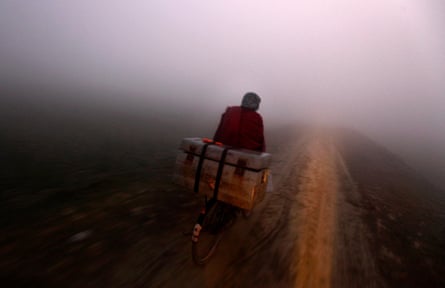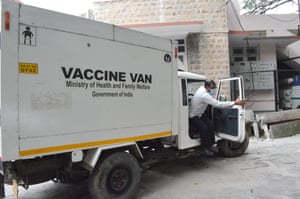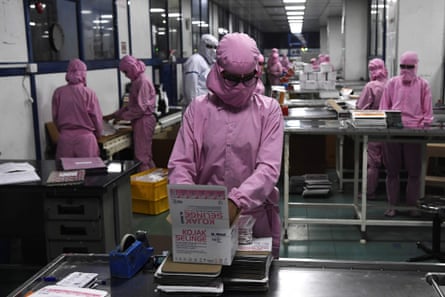A Brief Colonial History Of Ceylon(SriLanka)
Sri Lanka: One Island Two Nations
A Brief Colonial History Of Ceylon(SriLanka)
Sri Lanka: One Island Two Nations
(Full Story)
Search This Blog
Back to 500BC.
==========================
Thiranjala Weerasinghe sj.- One Island Two Nations
?????????????????????????????????????????????????Wednesday, December 9, 2020
India's biggest challenge: how to vaccinate 1.3bn people against Covid-19?
Analysis: Even with the world’s largest vaccination scheme already in place, the distribution at this scale has huge potential pitfalls
India’s claim to fame is staggering scale of its general elections, with 900 million voters mobilised across 1 million polling stations, to choose from 8,000 candidates across a landmass spanning 2,000 miles north to south and pretty much the same east to west.
But now the country has to go one better. India must vaccinate 1.3bn people against Covid-19 – twice and twice as fast. With more than 9 million confirmed cases of coronavirus and a battered economy, how will the country meet this challenge?
Prime minister Narendra Modi is confident. “We have a vast and experienced vaccination network and the country will capitalise on these advantages,” he said recently.
India already has the distinction of already having the world’s largest vaccination scheme – the universal immunisation programme. Every year, it administers vaccines for diphtheria, polio, measles and other childhood diseases to around 26 million infants, and it immunises about 30 million pregnant women.
India has 27,000 cold chain points (deep freezers and ice-lined refrigerators) to keep vaccines at the right temperature, 700 refrigerated trucks, around 50,000 cold chain technicians and about 2.5 million health workers to administer doses.
But in many places the cold chain system is in a sad state of repair. Fridge temperature gauges don’t work, vaccines are not stored or monitored properly, and power cuts can last hours, leaving vaccines unfit for use.
 |
The timescale for delivering the universal vaccine programme and Covid-19 vaccines is also very different. Vaccines for children and pregnant women are staggered over an entire year, whereas the coronavirus vaccination programme is expected to begin soon and the government wants approximately 300 million people (600 million doses) vaccinated by the end of August. They will include health workers, ancillary staff, sanitation workers, the police and vulnerable people.
Transporting the vaccine across a sprawling country, where the summer starts in March will also be a huge challenge.
Given the summer heat, the government is unlikely to opt for the Pfizer/BioNTech vaccine because its temperature requirement of -70C will be near-impossible to provide.
But even the more standard 2-8C refrigeration requirements of the Moderna or Oxford AstraZeneca vaccines will still mean that India will have to organise a gigantic scaling up of its existing cold chain capacity so that the moment the vaccine is available, refrigerated trucks can start making the long journeys to deliver doses to every corner of the country.
Trucks and trains will take the vaccine from the manufacturing plant to temperature-controlled storage centres in each state capital, equipped with walk-in coolers and freezers.

From the storage centres, the vaccines will be moved by truck, train and in some cases plane, todistrict headquarters, hospitals, health centres, clinics and chemists where once again they must be stored in freezers until administered.
Advertisement
Although the Modi government wants to act fast, and ministers speak with confidence of managing the logistical nightmare, apart from fuzzy reassurances, the government has provided few details. It has not been clear about when all the refrigerated trucks, storage centres, freezers, coolers, syringes, alcohol swabs and glass vials will arrive. Or how it plans to train the army of healthcare workers to give the vaccines.
“Has anyone done an audit of what we need?” said Dr Satyajit Rath, a scientist at the National Institute of Immunology. “We are not getting any specific figures. We’re told the existing immunisation set-up will be used but that is a drop in the ocean. The magnitude of the task is beyond the capacity of what we have, so what is the plan?”
plan?”
 |
State governments have begun to set up special taskforces. Some states, such as Bihar, Karnataka and Maharashtra, have told New Delhi how many ice-lined refrigerators, deep freezers, walk-in freezers and walk-in coolers they need. They are also compiling lists of the workers who will be on the priority list to receive the jab.
Some experts fear that vaccinations for children and pregnant women could fall by the wayside as delivering the coronavirus vaccine takes over the immunisation programme. The system simply won’t be able to cope with both demands, they say.
Childhood immunisation has already been disrupted by the pandemic. Figures from the health ministry show that between January and August, 12 million children were vaccinated, almost 6 million fewer than expected.
T. Sundararaman, coordinator of the People’s Health Movement, based in New Delhi, has warned that the cold chain capacity is inadequate even for the existing vaccination programmes.
“The government needs to ramp up the infrastructure by something like five to 10 times what we have now,” he said. “I see it mainly has a ‘hardware’ issue. How is it going to get the cold rooms, ice-lined refrigerators, vaccine vans and cold boxes? Even if they co-opt the private sector … cold chains are limited to urban pockets. They hardly exist in rural or remote areas.”
Plenty of private cold chain companies in India have said they can step into the breach and increase their capacity for the pandemic. Officials of Luxembourg-based B Medical Systems were in New Delhi last weekend for talks on supplying specialised refrigerated vaccine transportation boxes and freezers.
The supply of syringesalso seems to be on track. Hindustan Syringes, the country’s biggest syringe maker, said it will increase its output from 700 millionto 1 billion syringes a year to meet the expected demand both at home and abroad.
 |
But there is also the question of who will administer the vaccine. Millions of people will be needed. The All India Organisation of Chemists and Druggists has told the government it can train half of its 800,000 members to help administerdoses.
“The training to give injections, how to dispose of the syringe and how to look for side-effects has to be arranged, supervised, and monitored. We don’t know how that will happen. Even if chemists are trained, it won’t be enough,” Rath said. “We need more health workers on board. And while health workers are being deployed night and day to give the jabs, what about their normal duties to patients?”
Rath fears the rollout could descend into chaos if there are shortages and long queues of people outside clinics are turned away.
Nepotism will kick in and “the influential and the well-connected might try to muscle their way up the queue”, he said.


